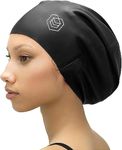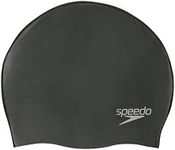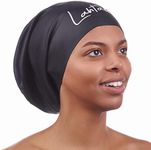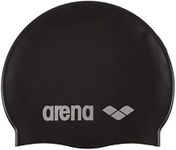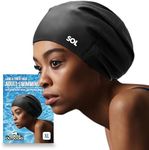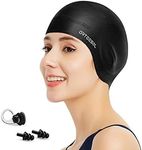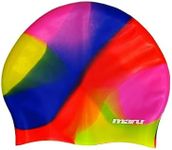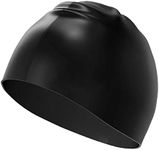Buying Guide for the Best Waterproof Swim Caps
When choosing a waterproof swim cap, it's important to consider factors that will enhance your swimming experience, whether you're swimming for leisure, training, or competition. A good swim cap should provide a snug fit to keep your hair dry, reduce drag in the water, and be comfortable to wear for extended periods. Understanding the key specifications will help you select a swim cap that meets your needs and preferences.MaterialThe material of a swim cap is crucial as it affects the cap's durability, comfort, and waterproofing ability. Common materials include silicone, latex, and lycra. Silicone caps are popular for their durability and excellent waterproofing, making them ideal for regular swimmers. Latex caps are thinner and more affordable but may not last as long. Lycra caps are comfortable and easy to put on but are not fully waterproof. Choose silicone if you need a durable and waterproof option, latex for a budget-friendly choice, and lycra for comfort if waterproofing is not a priority.
Size and FitThe size and fit of a swim cap are important for comfort and effectiveness. A well-fitting cap should be snug enough to stay in place without being too tight, which can cause discomfort. Swim caps generally come in adult and junior sizes, with some brands offering different sizes for varying head circumferences. To find the right fit, measure your head's circumference and check the manufacturer's sizing guide. If you have long or thick hair, consider a cap designed to accommodate more hair volume.
Design and StyleThe design and style of a swim cap can affect both its functionality and your personal preference. Some caps have a smooth surface to reduce drag, which is beneficial for competitive swimmers. Others may have textured surfaces or patterns for aesthetic appeal. Additionally, some caps come with ear pockets for added comfort. Consider a smooth design if performance is your priority, or choose a style that reflects your personality if aesthetics are more important to you.
Ease of UseEase of use refers to how easy it is to put on and take off the swim cap. Silicone caps can be more challenging to put on due to their snug fit, but they offer excellent waterproofing. Latex caps are easier to stretch over the head but may tear more easily. Lycra caps are the easiest to put on and take off but offer the least waterproofing. If you prioritize ease of use, a lycra cap might be suitable, but for better waterproofing, you might opt for silicone or latex, keeping in mind the trade-offs.
DurabilityDurability is an important factor, especially if you swim frequently. Silicone caps are known for their long-lasting nature and resistance to chlorine and other pool chemicals. Latex caps are less durable and may degrade faster with regular use. Lycra caps, while comfortable, are not as durable as silicone. If you swim often and want a cap that will last, silicone is the best choice. For occasional swimmers, latex or lycra may suffice, but be prepared for more frequent replacements.
